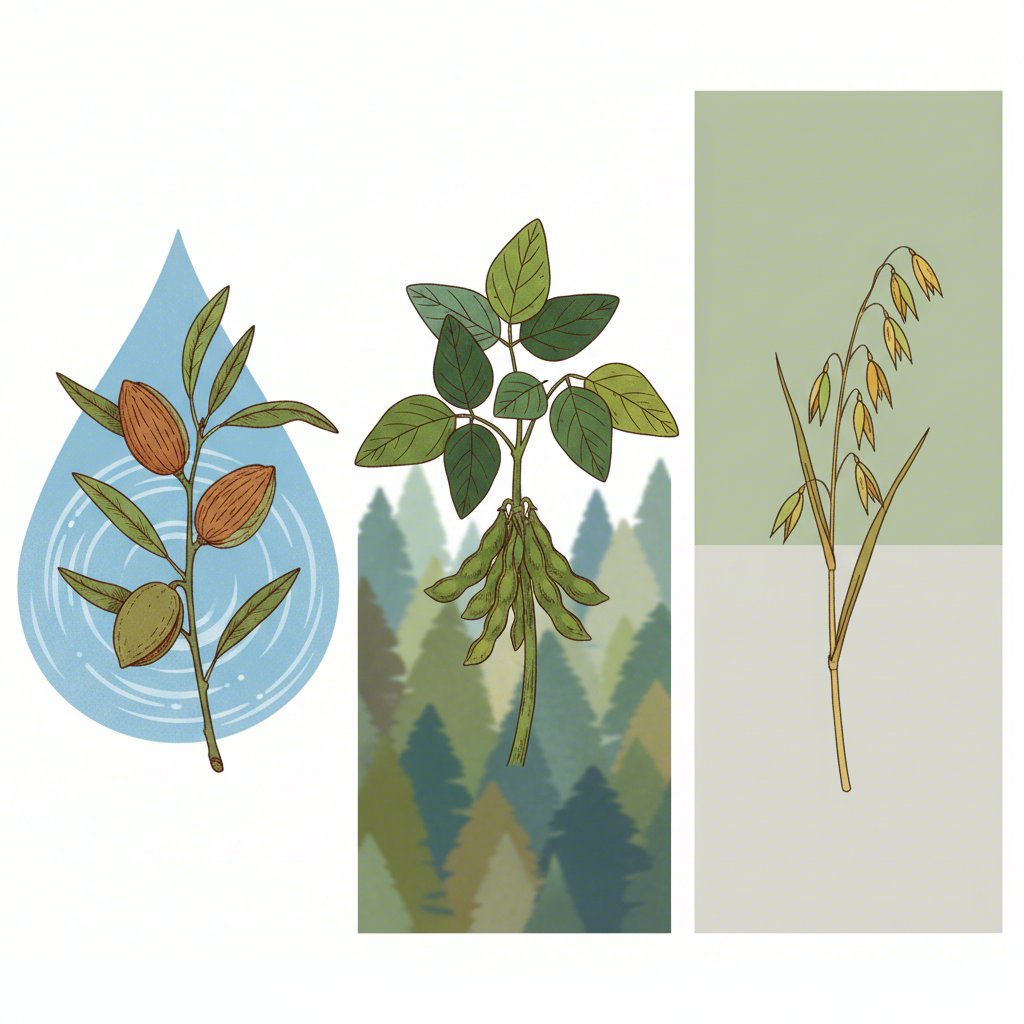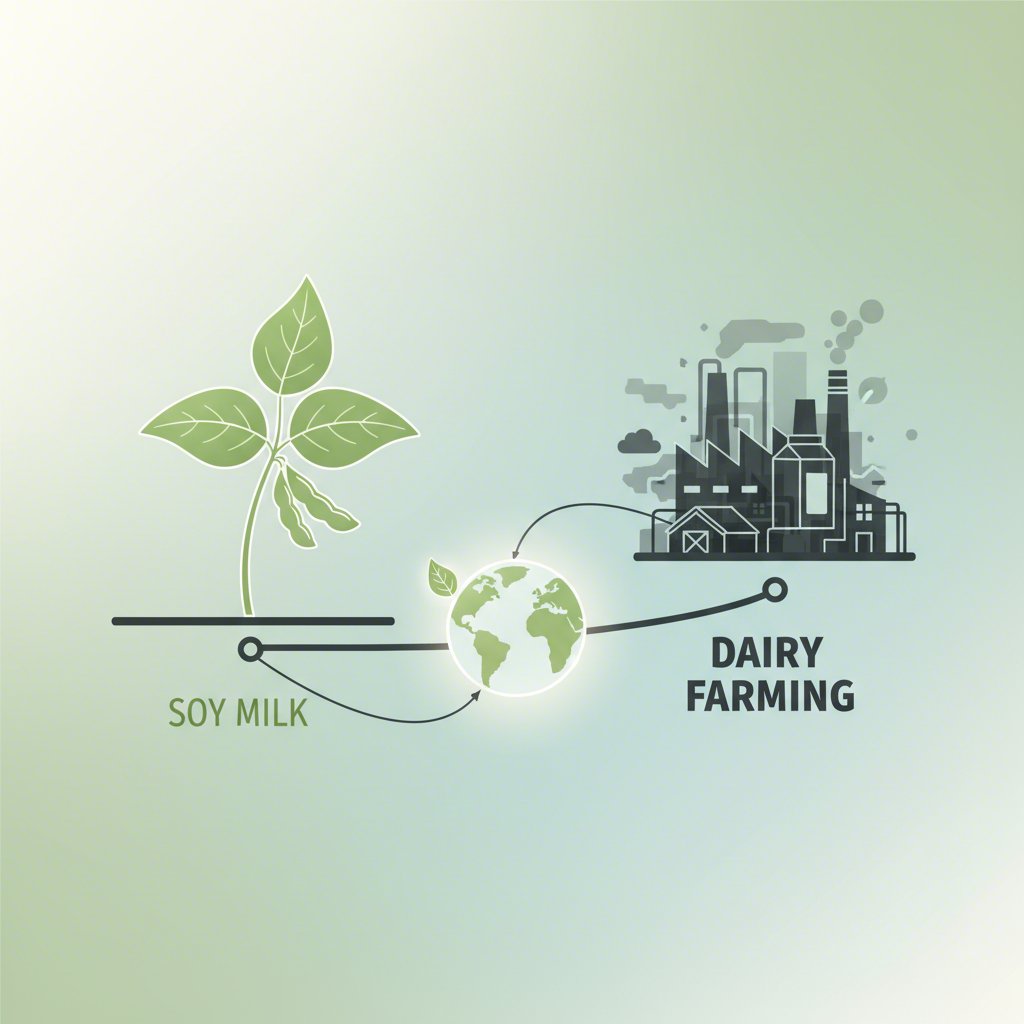TL;DR
The environmental impact of soy milk is significantly lower than that of dairy milk across key metrics like land use, water consumption, and greenhouse gas emissions. While soy cultivation is linked to deforestation, particularly in the Amazon, it’s crucial to note that the vast majority—over 75%—of global soy production is used for animal feed, not for making soy milk for human consumption.
Soy Milk vs. Dairy Milk: A Head-to-Head Environmental Comparison
When evaluating the environmental footprint of our dietary choices, the comparison between dairy milk and plant-based alternatives like soy milk reveals stark differences. The production of cow’s milk is an resource-intensive process, demanding vast amounts of land, water, and feed, while also generating significant greenhouse gas emissions. In contrast, soy milk production is markedly more efficient, placing a much lighter burden on the planet’s resources.
The primary environmental impacts of milk production are measured in three key areas: land use, water consumption, and greenhouse gas (GHG) emissions. Dairy farming requires extensive land for grazing cattle and cultivating their feed. Furthermore, cows release large quantities of methane, a potent greenhouse gas, as part of their digestive process. According to a comprehensive study from the University of Oxford published in Science, producing a single liter of cow’s milk requires about ten times more land than a liter of soy milk. This data highlights the inefficiency of converting crops into animal products versus consuming plant-based foods directly.
Water usage tells a similar story. The water footprint of dairy includes the water cows drink and, more significantly, the massive amounts needed to irrigate feed crops. Soybeans, by comparison, are far less thirsty. Data shows that a liter of soy milk requires only a fraction of the water needed for a liter of dairy milk, making it a more sustainable choice in water-stressed regions. The same applies to emissions, where dairy milk’s carbon footprint is approximately three times higher than that of soy milk.
| Environmental Metric | Cow’s Milk (per liter) | Soy Milk (per liter) |
|---|---|---|
| Greenhouse Gas Emissions | ~3.15 kg CO2eq | ~0.98 kg CO2eq |
| Land Use | ~8.95 m² | ~0.66 m² |
| Water Use | ~628 Liters | ~28 Liters |
Data sourced from Our World in Data, based on the Poore & Nemecek (2018) study in Science.
These figures clearly illustrate that on a liter-for-liter basis, soy milk is a substantially more environmentally friendly option than dairy. The efficiency of growing soybeans for direct human consumption, rather than cycling them through livestock, results in profound savings of critical natural resources and a significant reduction in climate-warming emissions.
The Deforestation Dilemma: Unpacking Soy’s Link to the Amazon
Despite its clear advantages over dairy, soy milk is not without environmental controversy. A significant concern is the link between soybean cultivation and deforestation, especially in the Amazon rainforest. It’s true that the expansion of soy farms has been a major driver of land clearing in regions like Brazil, leading to devastating biodiversity loss and the destruction of vital carbon sinks. This has led many conscientious consumers to question whether their soy latte is contributing to the problem.
However, the context behind this issue is critical. The overwhelming majority of soy grown globally is not for human consumption. According to multiple sources, more than three-quarters (over 75%) of the world’s soy is used as animal feed for the livestock industry, primarily for poultry, pigs, and cattle. Only about 7% of soy is consumed directly by humans in products like tofu, tempeh, and soy milk. This means the demand for meat and dairy is the primary driver of soy-related deforestation, not the demand for soy milk.
Furthermore, the origin of the soybeans matters greatly. Much of the soy used for soy milk consumed in North America and Europe is sourced locally, from farms in the United States, Canada, or Europe, where environmental regulations are stricter and deforestation is not a systemic issue. Many soy milk brands are transparent about their sourcing, often using certified organic or non-GMO soybeans grown far from the Amazon basin. By choosing brands that prioritize sustainable sourcing, consumers can effectively decouple their soy milk consumption from tropical deforestation.
Another way to ensure sustainability is by controlling the entire process yourself. For those interested in crafting fresh, additive-free plant-based milks at home, resources like Soy Milk Quick offer comprehensive guides on plant milk makers, helping you choose a machine that fits your needs and reduces packaging waste. This approach not only allows for control over ingredient sourcing but also minimizes the environmental impact associated with transportation and commercial packaging.

The Plant-Based Showdown: How Soy Milk Compares to Oat and Almond Milk
While soy milk is a strong environmental performer compared to dairy, the plant-based aisle offers a growing variety of alternatives, each with its own unique footprint. The most popular contenders—almond and oat milk—present different environmental trade-offs, making the ‘best’ choice dependent on which environmental factor is prioritized.
Almond milk, while having a very low carbon footprint and requiring minimal land, is known for its high water consumption. It takes a significant amount of water to grow almonds, many of which are cultivated in water-stressed regions like California. This makes almond milk a less-than-ideal choice for consumers whose primary concern is water conservation. Oat milk, on the other hand, is often highlighted as a well-rounded sustainable option. It generally requires less water than almond or dairy milk and has a low land-use footprint. Its greenhouse gas emissions are also very low, comparable to soy milk.
Soy milk remains a top contender, excelling in water and land use efficiency. Its protein content is also higher than most other plant milks, making it a more nutritionally comparable replacement for dairy. The main consideration, as discussed, is sourcing to avoid links to deforestation. When sourced responsibly, soy milk has one of the lowest overall environmental impacts.
| Milk Type | Greenhouse Gas Emissions | Land Use | Water Use |
|---|---|---|---|
| Cow’s Milk | High | Very High | High |
| Soy Milk | Low | Very Low | Very Low |
| Almond Milk | Very Low | Very Low | High |
| Oat Milk | Low | Low | Low |
Ultimately, choosing between plant-based milks involves weighing these factors. For an all-around low impact, oat and sustainably sourced soy milk are excellent choices. If water use is the top priority, almond milk is best avoided. Regardless of the choice, switching from dairy to any of these plant-based alternatives represents a significant step toward a more sustainable diet.
Beyond the Basics: Other Environmental Factors in Soy Milk Production
The environmental impact of soy milk production extends beyond the widely discussed metrics of land, water, and carbon. Other important factors include eutrophication, acidification, and the use of agricultural chemicals. These secondary impacts are often linked to the intensive farming practices required to grow any large-scale crop, including soybeans.
Eutrophication is the pollution of waterways with excess nutrients, primarily nitrogen and phosphorus from fertilizers. When these nutrients run off from fields into rivers and lakes, they can cause harmful algal blooms that deplete oxygen in the water, creating ‘dead zones’ where aquatic life cannot survive. Acidification, another concern, refers to the decrease in soil pH caused by pollutants like sulfur dioxide and nitrogen oxides, which can harm soil health and ecosystems. Soybean farming can contribute to these issues through the use of synthetic fertilizers.
The use of pesticides and herbicides in conventional soy farming also poses environmental risks. These chemicals can contaminate soil and water sources, harming non-target species, including beneficial insects and wildlife. However, it’s important to contextualize these impacts relative to dairy farming. The massive amount of feed crops required for livestock often leads to even greater fertilizer and pesticide use overall. Furthermore, animal waste from large dairy operations is a major source of nutrient runoff contributing to eutrophication.
Consumers can mitigate these secondary impacts by choosing soy milk made from certified organic soybeans. Organic farming standards prohibit the use of synthetic fertilizers and pesticides, promoting farming practices that build soil health and protect water quality. By opting for organic soy milk, you are supporting a system of agriculture that actively works to reduce its impact on surrounding ecosystems.
Your Sustainable Milk Choice
Ultimately, the evidence is clear: soy milk has a substantially smaller environmental footprint than dairy milk. Its production requires far less land and water while generating significantly fewer greenhouse gas emissions. While the issue of deforestation is a valid concern, it is overwhelmingly driven by the demand for animal feed, not soy milk. By choosing products made from sustainably sourced, organic soybeans, consumers can confidently enjoy a beverage that is both nutritious and kind to the planet.
When compared to other plant-based milks, soy holds its own as a top performer, especially regarding its low water usage and high protein content. The best choice for any individual depends on personal priorities, but shifting from dairy to a plant-based alternative like soy is one of the most impactful dietary changes one can make for a healthier planet.

Frequently Asked Questions
1. How does soy milk affect the environment?
Soy milk has a relatively low environmental impact compared to dairy milk. Its production generates about one-third of the greenhouse gas emissions, uses a fraction of the land, and consumes significantly less water. The primary environmental concern is deforestation associated with soy cultivation, but most soy is grown for animal feed, not soy milk.
2. What type of milk has the lowest environmental impact?
Generally, oat milk and soy milk are considered to have the lowest overall environmental impact. Both have low emissions, land use, and water use. While almond milk is low in emissions and land use, it is very water-intensive. All plant-based milks, however, have a smaller environmental footprint than dairy milk.
3. How does soy impact the environment?
Soy production’s main environmental impacts are land use change, which can lead to deforestation, and the agricultural inputs required for cultivation, such as water, fertilizers, and pesticides. However, the impact is highly dependent on where and how it is grown. The vast majority of soy’s negative impact is linked to its use as feed for livestock, not direct human consumption.
4. Are there any negative effects of soy milk?
From an environmental standpoint, the primary negative effect is the potential link to deforestation if the soybeans are not sustainably sourced. From a health perspective, most concerns have been largely debunked by scientific research. Some individuals may have soy allergies. For those with a history of oxalate kidney stones, it is sometimes advised to consume soy in moderation, but this is a concern for a specific health condition.
